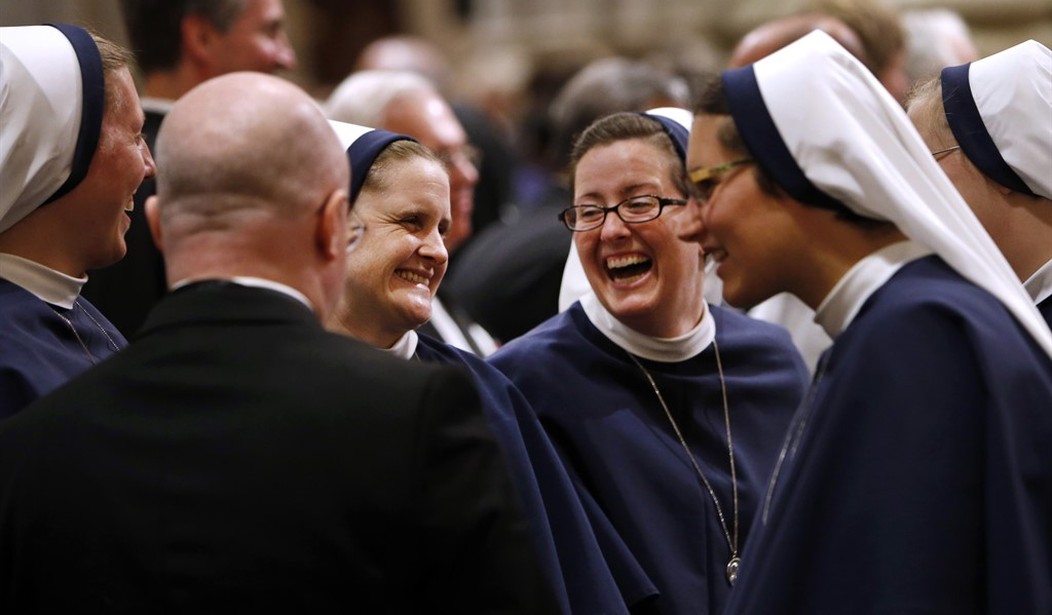In this case, the editors don’t even know the definition of what they write.
Plenty of nonsense gets said and written about Catholicism and its practices, mainly out of ignorance. As Bishop Fulton Sheen once remarked, “There are not one hundred people in the United States who hate The Catholic Church, but there are millions who hate what they wrongly perceive the Catholic Church to be.” Even without going so far as to use the word “hate,” what people think they reject as practices and doctrines of the Catholic Church are either entirely incorrect or taken out of full context.
Yesterday, however, The Atlantic published one of the more absurd and bizarre essays in this historied genre. In their attempts to paint all of Christianity as the forefront of radical nationalism, the Atlantic offered an opinion piece from Daniel Panneton headlined, “How the Rosary Became an Extremist Symbol.”
And every Catholic who read that likely had the same reaction: the rosary? The beads on which we count the number of Hail Marys and Our Fathers in the meditative prayer cycle that reflects on the mysteries of Christ and the Virgin Mary? The prayer cycle that goes back centuries, whose adherents include Catholics across the social and political spectrum?
In his opening, Panneton compares it to — wait for it — an AR-15, in what must be the Harmonic Convergence of Betes Noires:
Just as the AR-15 rifle has become a sacred object for Christian nationalists in general, the rosary has acquired a militaristic meaning for radical-traditional (or “rad trad”) Catholics. On this extremist fringe, rosary beads have been woven into a conspiratorial politics and absolutist gun culture. These armed radical traditionalists have taken up a spiritual notion that the rosary can be a weapon in the fight against evil and turned it into something dangerously literal.
Is the rosary an assault necklace? A fully automatic bracelet? Should we mandate capacity limits, ie, no more than one decade at a time? As far as it being “dangerously literal,” the only way that a rosary could become a “dangerously literal” weapon would be to try to strangle someone with it, and that’s only imaginable if you’ve never handled a rosary in your life and dealt with the fragile links and the tangling that routinely takes place. Nuns used rulers in school for discipline instead of rosaries. ‘Nuf said.
So what does Panneton mean by “dangerously literal”? “Stupidly symbolic,” it seems:
Their social-media pages are saturated with images of rosaries draped over firearms, warriors in prayer, Deus Vult (“God wills it”) crusader memes, and exhortations for men to rise up and become Church Militants. Influencers on platforms such as Instagram share posts referencing “everyday carry” and “gat check” (gat is slang for “firearm”) that include soldiers’ “battle beads,” handguns, and assault rifles. One artist posts illustrations of his favorite Catholic saints, clergy, and influencers toting AR-15-style rifles labeled SANCTUM ROSARIUM alongside violently homophobic screeds that are celebrated by social-media accounts with thousands of followers.
Wow — thousands of followers, eh? That might be impressive to The Atlantic and their writers. One question, however: how many Catholics are there in the world? Over 1.3 billion as of 2019, and 77 million in the US as of 2017. How many of those own rosaries? I’d wager most of them do, even if the percentage who actively and regularly pray the cycle is smaller. That number will still be on a scale several orders of magnitude larger than “thousands,” even just in the US. (Fun fact: my middle-of-the-road Catholic parish does a rosary service before Saturday evening Mass every week. Haven’t seen a radical yet.)
By the way, I have over sixty-three thousand followers on Twitter. Does that make the Sistine Chapel a symbol for the Die Hard Is Not a Christmas Movie sect? (If Storm Paglia and Matt Vespa are reading this, the answer is yes.)
Did the Atlantic think to check their math, or their facts? Heck, the editors didn’t even know the difference between a sacrament and a sacramental, as Jerry Dunleavy points out with this screenshot:
ah yea that famous Catholic “sacrament”, the rosary. pic.twitter.com/37mO7pgDg6
— Jerry Dunleavy (@JerryDunleavy) August 14, 2022
The rosary is a sacramental, not a sacrament. Panneton gets that much correct in the text, even if his editors can’t figure it out.
This essay is built on two parallel fallacies. It argues that because a tiny fringe of political extremists use the AR-15 symbolically, anyone who owns one must either be an extremist. It argues at the same time that the symbolic use of the rosary by a handful of extremists makes it a “dangerously literal” symbol — even though hundreds of millions of Catholics use the rosary for prayer. Both fallacies are intellectually bankrupt attempts to demagogue much larger groups by painting them as crypto-extremists rather than just criticize the actual extremists for their extremism rather than their stupid attempts to hijack others’ symbology.
Panneton also conflates spiritual warfare with actual warfare, and attacks actual church doctrine as somehow enabling of that conflation. This conflation results in rhetorical incoherence:
As Pope Francis said in a 2020 address, “There is no path to holiness … without spiritual combat,” and Francis is only one of many Church officials who have endorsed the idea of the rosary as an armament in that fight.
In mainstream Catholicism, the rosary-as-weapon is not an intrinsically harmful interpretation of the sacramental, and this symbolism has a long history. In the 1930s and ’40s, the ultramontane Catholic student publication Jeunesse Étudiante Catholique regularly used the concept to rally the faithful. But the modern radical-traditionalist Catholic movement—which generally rejects the Second Vatican Council’s reforms—is far outside the majority opinion in the Roman Catholic Church in America. Many prominent American Catholic bishops advocate for gun control, and after the Uvalde school shooting, Bishop Daniel Flores of Brownsville, Texas, lamented the way some Americans “sacralize death’s instruments.”
Say what? Weren’t we discussing the rosary and spiritual warfare in that paragraph? Panneton suddenly tosses in an argument on gun control that is entirely disconnected to the rest of the paragraph and quotes a grand total of one bishop offering his political opinion on guns. We can have a Catholic-teaching debate on gun ownership and self-defense (and I have on a number of occasions), but this ain’t it, pal. And no matter how much Panneton wants to return to his opening argument that the rosary has become a “dangerously literal” threat akin to the AR-15, he fails miserably.
This is even more laughable:
The militarism also glorifies a warrior mentality and notions of manliness and male strength. This conflation of the masculine and the military is rooted in wider anxieties about Catholic manhood—the idea that it is in crisis has some currency among senior Church figures and lay organizations.
I’m sorry, but this is almost satirical. Normally, we Catholics hear objections to the rosary as too focused on the feminine, with some suggesting that it indicates a worship of Mary. (It doesn’t, but that’s a topic for another time.) The rosary has 53 repetitions of the Hail Mary, as well as the Hail Holy Queen and a dialogue and another request for intercession from Mary at the end, compared to eleven Our Fathers, one Apostle’s Creed, eleven Glory Be prayers, and reflections on the mysteries of Jesus and Mary. If people want a prayer focused on the “warrior mentality and notions of manliness and male strength,” they’d be much better off using the Prayer to St. Michael the Archangel.
As for the rosary being “the most powerful weapon that exists on the market,” that is entirely in the context of spiritual struggle aimed at eternal life and salvation. It’s not exactly breaking news that Catholics believe in an afterlife as well as an ongoing spiritual battle between the Lord and Satan, and that our future is determined by that battle and our efforts to comprehend and participate in it. That is not an extreme position, but the mainstream position of Catholicism and Christianity in general. The rosary has existed for centuries and perhaps more than a millennium for the purpose of forming our souls to deal with that spiritual reality, using the power of prayer to muster our spiritual strength to help defeat evil in the greater spiritual existence. That’s what the Swiss Guards meant by that quote, and the only context in which the rosary could ever be considered a weapon of any sort, let alone a “dangerously literal” one.
What makes this an exponentially larger moral failure is the article that The Atlantic published two days earlier that excused actual “dangerously literal” violence because of “the Right.” Kaitlyn Tiffany’s essay, headlined “The Right’s New Bogeyman,” complained that conservatives had focused attention on a domestic terrorist group “Jane’s Revenge,” which had actually conducted a series of attacks on pro-life businesses in the wake of the Dobbs leak. Suddenly, The Atlantic was less concerned about actual violence and extremism … when it supports their own political point of view.
Do a few fools misunderstand the rosary and/or manipulate it as a temporal “weapon”? Yeah, sure. Not long ago, a few fools misinterpreted the banal and ubiquitous “OK” hand gesture too, after which the media tried painting everyone who used it as a — wait for it — toxic nationalist, too. This is more of the same nonsense: an attempt to demonize (SWIDT?) and marginalize over a billion people because some people with “thousands of followers” on social media use rosaries in their extreme symbology. This narrative speaks volumes about The Atlantic — and says nothing at all about the rosary, Catholics, Christians, or even “dangerously literal” domestic terrorists like Jane’s Revenge that The Atlantic defends in print.
Father forgive them, for they know not what they do … or write … or argue … or …








